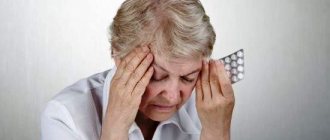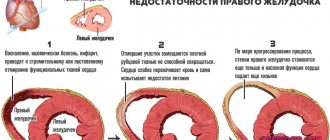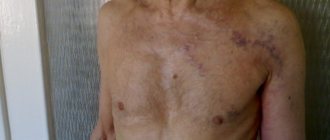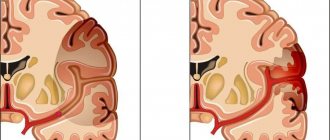Many people are interested in whether it’s normal for blood pressure to be 120 over 70 or not? The blood pressure reading for each individual will be individual. It, like nothing else, reflects the state of the human body and its cardiovascular system. Significant changes in blood pressure associated with heart or vascular diseases should not only alert you, but also be a reason to visit a doctor. Blood pressure is the sum of upper systolic and lower diastolic. That is, the lining of the blood vessels is under bilateral pressure. Air is on the outside, and blood is on the inside. The difference between these values is exactly what constitutes those same numbers - pressure indicators. Thus, from the indicator 120 to 70 it becomes clear that 120 is the top, and 70 is the bottom.
So, is blood pressure 120 over 70 normal, and what does this mean?
It is believed that the upper value characterizes the quality of functioning of the cardiovascular system, while the lower one reflects the functioning of the kidneys. Any disturbance in the functioning of the kidneys will greatly affect the heart and blood vessels. If the value between the upper and lower pressure does not exceed 50 points, then this pressure is within normal limits. This statement is true in the case when a person feels good with such indicators. However, it is always worth taking into account a person’s age, height, body constitution, weight and the presence of concomitant diseases. It is worth taking a closer look at what a pressure of 120 over 70 means.
When considering blood pressure, you should also pay attention to your pulse. After all, the pulse carries information about the heart rate. If the pressure is kept at 120 to 70 (normal pressure), then the pulse is approximately 70-80 beats per minute. That is, they are in a state of equilibrium. The most dangerous condition is an excessive decrease or increase in heart rate. An increase in the number of heart contractions is called tachycardia, a decrease is called bradycardia. Increased heart rate is characterized by hyperemia of the skin, an excited state, trembling of the limbs, tinnitus and pulsating blood. A weakened pulse is expressed in a general loss of strength, pallor, and lethargy. A changing pulse aggravates existing symptoms.
Blood pressure 120 over 70
A blood pressure of 120 over 70 was determined by doctors to be normal. Hypertension can be indicated by pressure that remains at the level of 140 over 100. And hypotension can be indicated if the indicator drops to the level of 100 over 60.
For women and men not older than 35, not of large build and without excess body weight, a pressure of 120 to 70 will be optimal. In older people, these numbers on the tonometer will indicate a decrease in pressure, because with age, pressure gradually increases in a completely natural way. If an elderly person maintains constant physical activity at a given pressure, then there is no reason to worry. This is fine.
And yet, is pressure 120 over 70 good or bad?
Normal or not
Pressure is the force exerted by the bloodstream on the surrounding vessel walls.
There are two types:
- systolic blood pressure;
- diastolic blood pressure.
The first reflects the process of pushing blood into the arteries, the second - at the moment of relaxation of the heart muscle. Physiologically, it is considered to be 120 to 80 (120, 125 to 70, 75, respectively). This is a good indicator for an ordinary healthy person without obvious pathologies or serious diseases.
Basically, with this value, you feel good, the heartbeat is calm, and breathing is not difficult. The person does not experience heaviness or pain in the head, or dizziness. True, this is just an average indicator; for a hypotensive patient, these figures will be disastrous, and a hypertensive patient will feel a clear decrease in blood pressure.
In general, it can vary from 100 to 60 to 140 to 90 and will be natural for its owner.
For example, with age, indicators increase, pressure 120 over 70 will be considered low, an elderly person will feel overwhelmed and weakened. If a woman is pregnant, the volume of the bloodstream increases, the heart does double work, so an increase cannot be avoided. It is necessary to keep the pressure under the supervision of a doctor, because any sudden fluctuations can affect the development of the fetus.
In teenagers
Teenagers 12-15 years old may already have this level of pressure, because the body is actively growing and rebuilding. This is especially true for teenagers with a strong physique and tall stature. If the child does not have other diseases, then this pressure will be normal. For children under 12 years of age, this level is hazardous to health. In young children, blood pressure should be within 60 to 40 and gradually increase until the age of 10 years. High blood pressure that is not appropriate for the child’s age indicates impaired renal function, excess weight, lack of physical activity, or, possibly, high salt content in food.
Causes of high blood pressure
The complaint that blood pressure rises is very common. With high blood pressure, if it is not reduced quickly, the patient complains of headaches, poor health, and dizziness. With high blood pressure, the patient often suffers from attacks of nausea and anxiety. Therefore, it is imperative to reduce blood pressure, especially when a person is alone at home.
When only lower pressure increases, the causes may be related to kidney pathologies. First of all, the doctor will suspect:
- atherosclerosis;
- stenosis;
- abnormalities in the development of renal vessels;
- glomerulonephritis.
If diastolic pressure rises to 105 mm, it persists for more than 2 years in a row, the likelihood of developing cerebral accidents increases immediately by 10 times, and myocardial infarction by 5.
Systolic blood pressure usually increases rapidly in elderly patients, with thyroid diseases, anemia, and heart defects. If your heart rate increases, it also increases the likelihood of a stroke or heart attack.
The causes of low blood pressure are associated with hypotension and weak heart function, and peculiarities of autonomic tone. In some diseases, blood pressure is constantly reduced:
- heart attack and subsequent cardiosclerosis;
- vegetative-vascular dystonia;
- prolonged fasting, body weight deficiency;
- myocardiopathy;
- hypothyroidism;
- diseases of the hypothalamic-pituitary system;
- adrenal insufficiency.
With minor hypotension, people can live a normal, full life. But when the upper pressure drops quickly and significantly, for example, during shock, this can cause multiple organ failure, centralization of blood circulation, and the development of disseminated intra-articular coagulation
Therefore, it is better to lower blood pressure gradually; it is extremely important to eliminate the causes of the disorders and try to keep the pressure within normal limits.
With high blood pressure, if it is not reduced, very dangerous irreversible changes in the body can begin.
Reasons for changes in blood pressure
The reasons for a change in blood pressure to the level of 120 to 70 depend greatly on what the person’s blood pressure usually is. If a person is prone to hypertension, then this indicator may indicate that the body now has a high level of a blood pressure-lowering drug or a diuretic drug. A decrease in pressure is accompanied by pale skin, faintness, drowsiness, and weakness. In hypertensive patients, this is observed very rarely and, as a rule, goes away quickly. Taking antispasmodic drugs for hypertension can have the effect of lowering the lower pressure limit. Taking medications to lower blood pressure should be done with caution. People prone to hypotension may experience an increase in blood pressure to levels of 120 over 70 due to severe stress, drinking alcohol, changing weather conditions, or consuming too much salt or caffeine.
Normal blood pressure for an adult
Enter your pressure
130 to 90
Search in progress Not found
Each person has his own physiological characteristics, and blood pressure is no exception. For adults there is no clear age norm for blood pressure, but in any case:
- the pressure should not be higher than 140/90 mm. rt. Art.;
- The normal average is considered to be 130/80;
- the optimal pressure will be 120.125/70.
As for the upper pressure limit, after which the patient is diagnosed with arterial hypertension, it is often 140/90 mm. rt. Art. If the numbers are higher, the body should be diagnosed to identify the cause of this condition. The blood pressure table will show all changes.
Initially, the doctor will recommend reconsidering your habits and lifestyle, giving up smoking, and doing as much physical exercise as you can. When a person's blood pressure quickly rises to 160/90, drug treatment is indicated. It happens that the patient manages to lower the tonometer readings without medications; sometimes it helps to simply lie down for a while and take a sedative.
It is possible that a hypertensive person has concomitant pathologies, for example, type 1, type 2 diabetes mellitus, and coronary heart disease. In this case, medications are taken at lower numbers.
If a person has arterial hypertension, the norm for him is 140.135/65.90 mm. rt. Art. In case of severe vascular atherosclerosis, blood pressure should be reduced gradually and smoothly. Very sharp changes in blood pressure will cause:
- myocardial infarction;
- stroke.
When there is a history of renal failure, diabetes mellitus, and the patient’s age is less than 60 years, his optimal blood pressure is 120,130/85.
In an absolutely healthy person, the lower pressure limits are within 110/65 mm. rt. Art. With even lower numbers, general health deteriorates; organs and tissues do not receive enough oxygen. First of all, the brain suffers, especially sensitive to oxygen starvation.
It is noteworthy that some people live quite normally with a blood pressure of 90/60 and have no health problems. Constant very low blood pressure occurs in former track and field athletes with hypertrophied heart muscle.
For an elderly person, too low blood pressure is undesirable, since it carries the threat of brain accidents
Therefore, it is very important for such people to have medications at home that help lower blood pressure. Nitroglycerin is an excellent drug for lowering blood pressure.
Diastolic blood pressure in people over 50 years of age should be between 85 and 89 mm. rt. Art. Measurements are taken on both hands at once with an interval of 1-3 minutes. It is normal if the difference between the obtained data is no more than 5 mm. In right-handed people, the muscles of the working limb are more developed, for this reason the blood pressure on it is usually slightly higher, and in left-handed people it’s the opposite.
Headache
A headache may also accompany a blood pressure of 120 over 70 - this is normal. Most likely, the cause should not be sought in the cardiovascular system. There can be many root causes of headaches, including:
- inflammatory processes;
- overexertion, neuralgia;
- poor nutrition;
- brain diseases;
- head injury;
- allergy;
- disruption of metabolic processes inside the skull;
- cluster type headache.
Each of the above reasons has clear, pronounced symptoms. Using it, it will not be difficult for a specialist to determine the disease. People prone to hypotension may experience headaches due to a sudden and uncharacteristic jump in blood pressure.
Adult blood pressure readings
Firstly, this requires the presence of special sensors in the vascular bed. And secondly, and more importantly, the pressure constantly fluctuates over a short period of time.
Therefore, this pressure is called systolic. During relaxation of the heart (diastole), the lowest pressure numbers are recorded. Both of these indicators are written through the symbol “/”. For example, a blood pressure of 120 over 60 is written as “120/60”. When the pressure in the cuff is greater than the pressure in the vessel, blood flow to the latter is impossible.
It is believed that a pressure of 120 to 60 millimeters of mercury ensures adequate exchange of gases and various substances. But other approximate indicators, for example, pressure 120 over 65 or 50-80, are normal. Beyond these numbers, pressure is considered pathological. The fact is that its decrease is below 90 mm Hg. Art. leads to cessation of kidney function. Their tubules are capable of filtering blood plasma at a pressure equal to or exceeding this value.
These are the heart, blood vessels and blood. And the most important indicator of its work is blood pressure. Now I felt unwell, I measured my blood pressure - it was normal, but my pulse was 91 per minute...
Cardiovascular system and blood pressure
The cardiovascular system includes three important components. These are the heart, blood vessels and blood. And the most important indicator of its work is blood pressure. This is primarily due to the fact that this hemodynamic indicator is the easiest to measure. The formation of blood pressure is based on the work of the heart and the state of vascular tone. Specifically, the calculation takes into account such indicators as minute blood volume (the amount of blood pumped by the heart in one minute) and total peripheral vascular resistance (abbreviated as TPVR). Measuring absolute numbers of pressure in blood vessels is quite difficult for two reasons.
Firstly, this requires the presence of special sensors in the vascular bed. And secondly, and more importantly, the pressure constantly fluctuates over a short period of time. The highest pressure numbers are observed during the contraction of the heart, called systole. Therefore, this pressure is called systolic. During relaxation of the heart (diastole), the lowest pressure numbers are recorded. It is called diastolic. Both of these indicators are written through the symbol “/”. For example, a blood pressure of 120 over 60 is written as “120/60.” This entry means that the systolic pressure is 120 millimeters of mercury, and the diastolic pressure is 60.
Vitamins
At a level of 120 to 70, any serious treatment is rarely prescribed. All measures will most likely be aimed at normalizing blood pressure and bringing it back to normal. Blood pressure is in close connection with the nervous system, and, as a result, all changes in its condition are reflected in blood pressure. If the identified cause is neurological, the doctor may prescribe sedatives, vitamins, a special diet and adjustments to the daily routine. The nervous system quickly returns to normal if the body receives the necessary vitamins, feasible physical exercise and is often in the fresh air. The best vitamins to combat pressure surges are B vitamins, because they strengthen the walls of blood vessels and maintain the necessary tone. As for the diet, it is necessary to give preference to natural products and exclude fatty foods, semi-finished products and smoked foods.
Blood pressure 130/60 in pregnant women
In healthy pregnant women, blood pressure does not change until the sixth month of pregnancy. Blood pressure is normal in non-pregnant women.
Further, under the influence of hormones, some increases may be observed, not exceeding 10 mm from the norm. In a pathological pregnancy, gestosis may occur with surges in blood pressure, damage to the kidneys and brain (preeclampsia), or even the development of seizures (eclampsia).
Pregnancy against the background of arterial hypertension can worsen the course of the disease and provoke hypertensive crises or a persistent increase in blood pressure. In this case, correction of drug therapy, observation by a therapist or treatment in a hospital is indicated.
Such pressure parameters are sometimes determined during pregnancy. They are regarded as a variant of the norm. Pulse pressure increases due to the placenta, the area of which is a venous-arterial fistula.
If a woman feels well, a decrease in diastolic blood pressure is not a cause for concern. In doubtful cases, the gynecologist may prescribe Dopplerography of blood vessels to find out the cause of the deviation or to make sure that the fetus receives the necessary nutrition and does not suffer from hypoxia.
Pills
Many people are interested in what pills to take and what to do if the pressure is 120 over 70. Minor fluctuations can be prevented with the help of certain sedatives. For this purpose, the doctor may prescribe Corvalol drops, tincture of valerian, peony or motherwort. The exact dosage should be observed and be sure to take medications immediately before bedtime. If there is a need to strengthen the nervous system, then medications with magnesium and Glycine are additionally prescribed.
These drugs will also become a kind of protection against stress. Those who have a direct relationship between pressure surges and the state of the body’s nervous system should definitely take medications for prevention. In case of blood pressure disorders, special attention should be paid to vascular health. The drug "Ascorutin" is prescribed for the purpose of prevention and improvement of the functioning of the body's vascular system. Both high and low blood pressure can be normalized if you walk in the fresh air every day and learn to relax properly. Many people find breathing exercises, yoga or other relaxation techniques help with this. Sleep should always be complete, because sleep disturbances most often cause changes in blood pressure.
The above measures are not treatment; they are more aimed at prevention, because a pressure of 120 over 70 is normal.
First aid
What does a blood pressure of 120/60, a pulse of 60 mean, and if at the same time you feel minor malaise and weakness? It is necessary to ensure a horizontal position. It is advisable to ventilate the room and perform light breathing exercises.
The main thing in this situation is not to be nervous and not to panic, since it is important to understand that with such pressure there is no threat to life.
You can also drink warm sweet tea, and in the evening it is better to go to bed early to restore your strength in the morning.
If the above measures do not help and the condition continues to worsen, you should call an ambulance.
It is not recommended to take medications that affect blood pressure on your own. You are allowed to take only those medications prescribed by your doctor.
Patients with high pulse pressure are sometimes prescribed ACE inhibitors, potassium and magnesium supplements, and folic acid.
The latter drug helps increase the strength of the arteries and prevents the development of, among other things, systolic hypertension.
In the first half of the day, for hypotension, it is recommended to drink coffee and tea, but you should not abuse them. Psychotherapy courses, as well as massage, aromatherapy, water treatments, physical therapy, and acupuncture have a good effect.
The home medicine cabinet of a person suffering from hypotension may contain the following products:
- "Ephedrine";
- "Caffeine";
- "Piracetam";
- "Cinnarizine";
- herbal preparations (tinctures of Eleutherococcus, ginseng);
- succinic, folic acid;
- vitamin complexes.
conclusions
The norm of blood pressure will be different for each person, because it is influenced by various factors. These are age, gender, chronic diseases, especially heart and vascular diseases. Normally, this is a pressure of 120 over 70, and we’ve already figured out what it means. If you are feeling well, this should not be a cause for concern. For hypotensive patients this is increased blood pressure, for hypertensive patients it is slightly lowered, but in any case it does not pose a threat to health. If such pressure is associated with other unpleasant symptoms, you should consult your doctor as soon as possible. This is not a joke.
Unfortunately, normal pressure is not enough to consider the body completely healthy. A person’s blood pressure level of 120 over 70 is most typical for people between 18 and 50 years old. To maintain your blood pressure at an optimal level, do not neglect preventive tips for a healthy lifestyle. What needs to be done? Sports, walks in the fresh air, a balanced diet, timely medical examination and the absence of stress will definitely bring your blood pressure levels back to normal.
Symptoms
If a person's blood pressure is 125 over 65, they may experience symptoms:
- lethargy, fatigue;
- fast fatiguability;
- sensations of cold, chills;
- headache;
- dizziness;
- heartache;
- sensitivity to weather changes;
- feeling of emotional distress;
- The problem is thermoregulation.
Reduced lower pressure is manifested by a number of general symptoms that can be attributed to fatigue. Therefore, you need to listen to your body and, at the slightest suspicion, consult a doctor.
A decrease in diastole pressure may not be felt at all: a person may lead a normal life and not suspect that he has some kind of malfunction in the body. But some people acutely feel even 5 units of pressure and immediately react to changes.
Most often, patients complain of headache. It can be localized in the temples and back of the head.
One of the unusual sensations is sometimes a feeling of a lump in the throat. A person constantly wants to sleep, he is irritable.
More clear symptoms include darkening of the eyes, increased heart rate, dizziness, and flashes before the eyes. There are sensations in the gastrointestinal tract, nausea.
People with low blood pressure feel the change in weather well, have difficulty waking up, but feel better by the afternoon.
Some people feel absolutely fine with a blood pressure of 120 over 60. But in most cases, symptoms are still present. Low diastolic pressure is indicated by:
- “floaters” in the eyes;
- dizziness;
- drowsiness;
- an unreasonable feeling of fatigue;
- pain in the back of the head and temples;
- nausea;
- chills;
- feeling of a lump in the throat;
- slight numbness of the tongue and limbs;
- cardiopalmus;
- irritability.
People with such indicators are usually very weather dependent. They react to any change in weather by exacerbating symptoms. As a rule, they feel well during the day, but in the evening their health begins to deteriorate.
This symptomatology is typical for blood pressure 120 to 60 and 125 to 65 mm Hg. st:
- Frequent dizziness, especially with sudden movements;
- Fainting;
- In almost all cases, headaches (throbbing or aching pains) of a constant nature;
- State of apathy and indifference;
- Deterioration in performance, absent-mindedness;
- Also, symptoms may intensify with a sudden change in weather;
- Numbness of the tip of the tongue;
- Cardiopalmus;
- Increased irritability.
The pulse is determined by the difference between the upper and lower blood pressure. Normal values for a healthy person are 60-90 beats per minute. If the upper blood pressure is 120 and the lower 60, the pulse pressure is 60 beats per minute. This is considered the norm.
If your blood pressure is 120 over 65, then the difference between the upper and lower readings is 55 units. For the pulse, this figure is no longer the norm; the ratio 120/65/55 most likely indicates the development of some disease.
With rapid heartbeat, the pulse rate can be up to 120 beats per minute - at this pulse rate, serious pathologies are most likely present in the body. This could be chemical poisoning, acute heart failure, exacerbation of an existing latent disease, or the initial stage of collapse.
| Systolic blood pressure (mm Hg) | Diastolic blood pressure (mm Hg) | Pulse (beats per minute) | Normal or not? |
| 122 | 66 | 56 | No |
| 124 | 67 | 57 | No |
| 126 | 66 | 60 | Norm |
| 127 | 67 | 60 | Norm |
| 128 | 68 | 60 | Norm |
What to do with such blood pressure?
Elimination of accompanying symptoms is considered an urgent measure, and this does not negate the identification of the cause of this disorder. To do this, you need to go to a therapist, who will prescribe treatment or refer you to see highly specialized doctors (cardiologist, neurologist, etc.).
Drugs that lower or increase blood pressure are not required in this case if you feel normal. If you feel unwell, then it is enough to take something for the headache. To normalize the condition on your own for a long time, it is recommended to adjust your lifestyle.
If diastolic pressure drops, the first aid may be:
- taking a contrast shower or warm bath (depending on personal preference);
- performing gymnastics (several exercises);
- essential oils (tonic, invigorating);
- food and drinks;
- preparations (tincture of ginseng, lemongrass, Rhodiola rosea, golden root).
Do not self-medicate with medications that regulate blood pressure (not prescribed to you by a cardiologist or therapist), otherwise this may result in, at best, a temporary deterioration in your condition, and at worst, death.
You cannot decide on your own to take any medications that affect your blood pressure. If used incorrectly, they can worsen the situation. If you have doctor’s recommendations received at your appointment, you must strictly follow them.
Why does systolic blood pressure decrease?
With general hypotension, both indicators often decrease: upper and lower. This happens proportionally.
If there is a sudden decrease in only the upper pressure, for example, 100/80, 90/80, the person begins to experience a deterioration in health: dizziness, problems with coordination and balance. His eyes may suddenly darken, especially when changing body position and sudden movements of the head. The person turns pale, it is very difficult for him to stand on his feet for a long time, or to be in transport; he can hardly stand the heat and stuffiness.
To partially normalize blood pressure, it is better for a person to take a horizontal position (head lower than feet): blood flow to the brain will increase, and he will no longer experience oxygen starvation, which is inevitable with systolic hypotension.
What reasons can lower blood pressure
The decrease in upper A/D may be short-term. The background for the problem may vary:
- stress and nervous tension;
- severe fatigue;
- physical overload;
- sudden change in weather;
- change of climate zone and the need for acclimatization.
In this case, drug therapy is not prescribed. Indicators are brought back to normal by changing a person’s lifestyle and, if possible, eliminating negative factors.
If systolic pressure is always low and diastolic pressure is normal, a clinical health study is required. You need to consult with a therapist, cardiologist, endocrinologist, nephrologist and psychotherapist. The help of a gastroenterologist and hematologist may be required.
You will definitely need to donate blood for general and biochemical analysis. If no pathologies are detected, such A/D can be considered an individual feature.
Often, a decrease in systolic indicators is observed in pregnant women in the first three months, during the formation of the placenta.
In athletes with active daily loads, examinations often reveal a decrease in upper A/D. As a rule, athletes themselves do not experience symptoms of deteriorating health. This is explained by the fact that the trained heart muscle, at rest, saves energy and slows down the rhythm.
Changes in atmospheric pressure, temperature fluctuations from plus to minus when changing time zones, different oxygen levels in the air: all these factors will affect the upper level of pressure until a person adapts to unusual conditions.
Serious reasons
A decrease in upper A/D can provoke serious diseases:
- bradycardia (slow heart rate);
- heart pathologies;
- decompensated diabetes mellitus.
If, when monitoring A/D, the systolic pressure is below normal, and you feel unwell, you should not treat yourself. The doctor will diagnose the disease, prescribe the correct treatment, and the symptoms of systolic hypotension will no longer bother you.
About the features of pulse changes
Things are different if, in parallel with the change in blood pressure, the pulse also changes. The normal heart rate ranges from 60 to 70 beats per minute. Exceeding this indicator (over 90 beats) is usually called tachycardia, which entails the following conditions:
- Tremor of the hands.
- Hyperemia.
- Overexcited person.
- Noise and pulsation in the ears.
When the heart rate decreases below 60 beats, bradycardia is diagnosed, which is accompanied by the following symptoms:
- Half-fainting state.
- Apathy.
- Pallor of the skin.
- Darkening in the eyes.
Practice shows that bradycardia and tachycardia can be diagnosed even with normal blood pressure, in which case it is necessary to seek qualified advice. These conditions are often concomitant factors in the development of other diseases.
How to treat the condition
Treatment is etiological, aimed at eliminating the root cause of the pathological process. Without knowing a specific diagnosis, it is impossible to say anything about the methods.
Both conservative and surgical methods for correcting the condition are used. Symptomatic therapy is also carried out to eliminate manifestations. It consists of taking tonic drugs in strictly limited dosages.
A radical change in lifestyle is expected: giving up bad habits, normalizing diet and nutrition, using physical therapy methods, etc.
Diagnostics of diastolic pressure 60 and below
If your health worsens and negative symptoms appear, your blood pressure should be measured. Moreover, if the lower pressure is 60, this does not mean at all that something in the body is disturbed. This indicator is the norm.
But when it decreases significantly and the values are quite often or constantly low, you need to consult a doctor. The therapist will examine the patient’s symptoms and complaints and issue a referral for blood and urine tests.
Based on their results, the picture of the disease will become somewhat clearer.
With reduced hemoglobin, anemia will be diagnosed, high SOE will be the result of an inflammatory process in the body, and other indicators are evidence that there may be disruptions in the functioning of certain organs.
The doctor will also prescribe further examination or consultation with specialized specialists: cardiologist, neurologist, endocrinologist, oncologist, etc.
If cardiac pathologies are suspected, the therapist will send the patient to a cardiologist. The examination will consist of electrocardiography at the initial stage. Echocardiography and MRI may then be ordered.
When symptoms and tests indicate hormonal imbalance or diseases of the endocrine system, the patient is recommended to visit an endocrinologist.
A specialized specialist will prescribe glucose, an examination in the form of blood tests for hormones, and an ultrasound examination of the thyroid gland.
Treatment of hypotension
Sometimes, lifestyle and dietary adjustments to raise blood pressure may not be enough. Then, the attending physician prescribes therapeutic treatment, recommending certain medications.
As a rule, herbal medicines are prescribed first. They have a delicate effect on the cardiovascular and nervous systems. Have a mild stimulating effect. Especially often, patients are recommended to take certain doses of the following alcohol tinctures:
- Eleutherococcus;
- aralia;
- lemongrass;
- ginseng.
If the therapeutic effect is insufficient, synthetic drugs can be added: anticholinergics, adrenergic agonists, nootropics, analeptics.
Only a doctor should recommend certain medications, set their dosage, and duration of use. Self-medication is unacceptable.
Excellent results are achieved using physiotherapeutic methods. This can be a massage, electrotherapy (Darsonval, electrosleep), baths with the addition of essential oils, Charcot's shower.
Lower pressure drops, negative symptoms appear
It is unlikely that a person who has measured unusual blood pressure readings and also feels not very well will not understand that it is necessary to look for the cause of this condition. If you have the same 120/60, but you understand why this could be (weather, physical activity, medications, lack of sleep), you will try to somehow eliminate the provoking causes. If the situation repeats itself, and your health becomes worse, a banal good sleep or rest may not be enough.
What symptoms should you be wary of:
- Frequent headache with pressure in the temples and back of the head;
- Lethargy and drowsiness;
- Numb tip of tongue;
- Dizziness;
- Feeling chilly;
- Mild nausea;
- Dark circles appearing every now and then before the eyes.
First, just take a voucher to see a therapist. He will tell you what examinations to undergo and which specialist to make an appointment with. But, most likely, he will send you to both a cardiologist and a neurologist. In some situations, you will also need to consult an endocrinologist.
Just don’t become a self-diagnosticist - you can “get to the bottom” of such diagnoses that a psychiatrist will then join your treatment.
Formulas for calculating pressure
Each person is individual and the pressure is also individual. The normal pressure is determined not only by age, but also by other parameters: height, weight, gender. That is why calculation formulas were created that take into account age and weight. They help determine what pressure will be optimal for a particular person. In this article, we will consider 2 formulas and 2 tables taking into account age and gender.
First formula . Volynsky's formula calculates the norm taking into account age and weight. Used in people aged 17–79 years. Upper (SBP) and lower (DBP) pressure indicators are calculated separately.
SBP = 109 + (0.5 * number of years) + (0.1 * weight in kg.).
DBP = 63 + (0.1 * years of life) + (0.15 * weight in kg.).
As an example, let's use the Volynsky formula to calculate normal blood pressure for a person aged 60 years and weighing 70 kg.
SAD=109+(0.5*60 years)+(0.1*70 kg.)=109+30+7=146
DBP=63+(0.1*60 years)+(0.15*70 kg.)=63+6+10.5=79.5
The normal blood pressure for this person, 60 years old and weighing 70 kg, is 146/79.5
Second formula: This formula calculates normal blood pressure taking into account only age. Suitable for adults from 20–80 years old.
SBP = 109 + (0.4 * age).
DBP = 67 + (0.3 * age).
As an example, using this formula, let’s calculate the blood pressure of a person aged 50 years.
SAD = 109+(0.4*50 years)=109+20=139
SBP = 67+(0.3*50 years)=67+15=82
The normal blood pressure for a person aged 50 years is 139/82.
Pulse
Unpleasant symptoms can bother both hypertensive and hypotensive patients, especially if the pulse changes. In a healthy adult, a pulse of 60-70 beats per minute is considered normal. If, along with a surge in pressure, there is an increase in the number of heartbeats of more than 90 per minute, tachycardia is diagnosed. This condition is accompanied by:
- trembling in hands;
- tinnitus;
- overexcitement;
- redness of the face.
If the number of heart contractions is less than 60, this is bradycardia. A person develops a semi-fainting state, his eyes darken, apathy and pale skin are noted.
Bradycardia and tachycardia can occur with normal blood pressure. This condition is a concomitant symptom in the development of diseases of the cardiovascular system.











